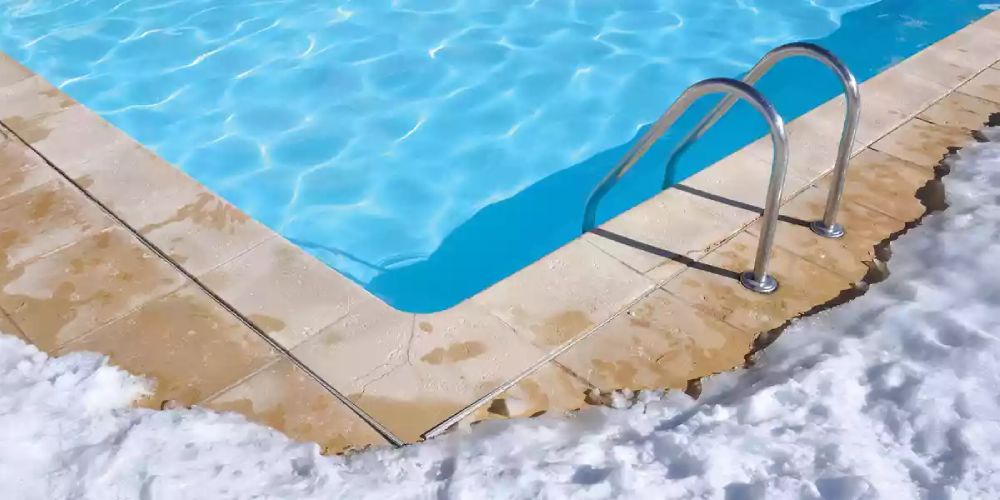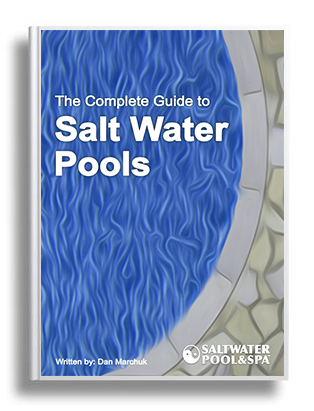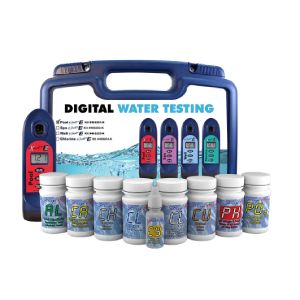- Salt Water Pool and Spa
- Salt Water Pool Maintenance
- Opening a Pool
Opening a Pool Guide
If you want information about opening a pool for the season you've come to the right place. After the snow has started to melt it's that exciting time when pool owner's start thinking about relaxing in the sun and going for relaxing dips in their pool. There are a few very important steps required for getting your pool started on the right track that will save you time and money in the long run and we’ll go through them all.

Opening a pool is not something everyone enjoys doing but getting your pool started properly after the winter is very important. Taking extra time now will help you avoid costly repairs and maintenance during the long season. If you find that you are uncomfortable with the do-it-yourself approach you can always contact a local pool professional to help you with your pool opening.
The Complete Guide to Salt Water Pool MaintenanceEverything you need to know to maintain your salt water pool and keep it running smoothly all season. |
|
Opening A Pool Step by Step
If you are handy pool owner the steps below should be fairly simple if you take your time and make sure chemicals are balanced and salinity is within the recommended range. The ideal salinity level or salt concentration will be outlined in the manufacturers instructions for the specific model you own and should always be followed as it does vary with different chlorine generator units.
If this is your first time opening a pool it may take a bit longer to get everything set up and your water balanced but every year as you learn your pool it will get easier and take a lot less time. A mistake that most new pool owners make is over-treating the pool water so it's important to get a good idea of the chemistry with a quality test kit that we'll discuss below.
If you own a salt water pool and chlorine generator there are some specific instructions we'll go over as well. Pool owner's that experiences freezing temperatures in the winter should wait until there is no threat of temperatures dropping below freezing before starting these steps. If you are an above ground pool owner we've put together instructions specifically for above ground pool opening for regular and salt water pools.
- Clean and Remove Cover
- General Cleaning and Inspection
- Adjust Water Level
- Cleaning and Inspection
- Water Chemistry
- Install Hardware
1. Clean and Remove Pool Cover
The main goal when removing any style of pool cover is to ensure there is no debris or dirty water on the cover before removing it. Any debris still on the cover might end up in your pool costing you more time to remove the leaves or twigs from the water and putting more stress on your filter system.
If your pool is adjacent to trees that shed in the winter you might want to consider using a pool leaf cover or net if you notice you have a lot of leaves or similar debris on your cover in the spring. A leaf net can be placed on top of the cover in the fall and makes the process of opening a pool a whole lot easier come springtime.
If you are using a hard cover you may need to pump or drain the water off that's collected over the winter months before removing it. A submersible pump or sump pump is ideal for this task and worth every penny if you plan on opening your pool properly over the years. After the cover is removed, spray it off with a garden hose or pressure washer before storing it for the pool season.
Sun2Solar Blue Pool Cover Heat Blanket in Various SizesIf you click on this link and make a purchase, we may earn a commission. |
2. General Cleaning and Inspection
If you were able to remove the cover and it was installed properly in the fall you should have a relatively clean pool to work with. If you didn’t use a cover or ended up with debris in your pool this is the time to remove larger debris that may have ended up in your water either by hand or with a pool rake. The skimmer basket tends to collect leaves and other debris over the winter and into spring and it will probably need a good clean. If you used a Gizmo or any other skimmer freeze protection devices, you should remove them.
At this step of opening a pool it’s a good time to do a general inspection of your entire pool system. You want to keep an eye out for anything out of the ordinary including leaks, breakages and general wear and tear. If your pool is relatively clean give the liner, walls and deck a good clean if required. If you suspect a tear in your liner refer to our pool liner repair page for helpful tips and advice.
3. Adjust Water Level
Ensure that all plumbing is reattached and close any valves left open during fall closing. If you disconnected electricity, now is a good time to reconnect power. If you are using a salt water pool system reinsert the salt cell if it was removed during winterization. Check the pool cell chlorinate to make sure it looks clean with no calcium build. It's a great idea to clean the pool cell during pool start to ensure it's producing chlorine properly. Always use caution with electricity to avoid electrical shock.
Add water to bring up to the appropriate level for normal pool operation. After this level is achieved and you’ve removed any large dirt or debris it’s time to start the pool system. It is normal for some air to be left in the system that will purge on its own in the form of air bubbles in the water as water begins to cycle from the plumbing.
Hayward T-Cell-15 Chlorinator for Salt Water Pools up to 40,000 GallonsIf you click on this link and make a purchase, we may earn a commission. |
4. Cleaning and Inspection
With the pool water clean and the filter system operating smoothly it’s time to do any final cleaning. This step of opening a pool can be reinvigorating as you will start to see the light at the end of the tunnel. You can use a brush, some old fashioned elbow grease or a pool vacuum for this step to get your pool looking sparkly clean and inviting.
A this point you should make sure that your entire pool system including the pump, filter, chlorine generator and heater are working properly. It's also a good time to ensure that your zinc anode is still in good shape if you have a salt system and have installed this device.
5. Water Chemistry
This is the most important step to opening a pool properly in the spring after the water has been sitting stagnant over the winter months. The chemistry will have altered over the winter months and it will need to be balanced. If you plan on balancing the water chemistry yourself we recommend a good salt water test kit so you know exactly what needs to be adjusted and don't get caught in the over treating nightmare.
As a salt water pool owners it's extremely important that you get the salinity levels correct so the chlorine generator will function optimally throughout the season. If levels are too low it won't produce enough chlorine while high levels could cause damage to your salt cell and pool surfaces. If you want more detailed information about pool salt and a calculator for adding the right amount, be sure to visit our pool salt page.
As you adjust the chemistry and salinity of your pool it's important to allow the water to circulate by leaving your pool system and pump running for at least 12 hours. You should keep your chlorine generator turned off during this initial circulating and mixing until you are satisfied with your pool chemistry. If you want more detailed instructions on chemistry and balancing visit our salt water pool maintenance page.
The easiest and most efficient way to get your pool started on the right track is to purchase a pool opening chemistry test kit. A complete test kit will include everything you need to check and monitor the pool water and get your pool healthy and ready to work all season long. One of the many benefits of salt water is the chemistry will remain more stable than a regular chemical chlorine pool. A quality pool test kit will take the guesswork out of it and provide accurate results.
ITS Complete Digital Pool Test KitThis digital test kit will test for everything you need to monitor including salinity with 25 different instant test results. If you click on this link and make a purchase, we may earn a commission. |
Check out our other articles that deal specifically with issues that may arise in your pool especially after it's been inactive over the winter months.
- How to shock a pool
- How to kill algae when it's got out of control
- How to clear up cloudy pool water
- How to get pool tiles clean and clear of scum buildup
- The latest in smart water care for your pool chemistry
6. Install Hardware
It’s time to install all the things that make your pool functional and fun for family and friends. If you removed all hardware and stored them over the winter they should be in great condition for the coming season but it’s a good idea to give them a good inspection at this step of opening a pool. Inspect handrails, ladders, and diving board to ensure they are free of cracks or obvious damage that could pose a safety hazard. They may require replacement or a new finish if they are worn from the previous pool season.
If proper pool closing or winterizing was completed in the fall it can be really simple opening a pool in the springtime. It will get easier every spring so if you’re a new pool owner don’t get discouraged if the process took longer than you expected. The best part is that after you have taken time to get your pool ready properly it’s ready to enjoy.
Disclaimer
Please use all appropriate and proper safety precautions when attempting projects on this website. All projects are attempted at the reader's own risk.
Salt Water Pool and Spa™ participates in the Amazon Services LLC Associates Program, as an Amazon Associate we may earn a commission from qualifying purchases.



